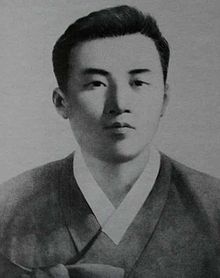This article has multiple issues. Please help improve it or discuss these issues on the talk page. (Learn how and when to remove these messages)
|
Kim Hyong-jik (Korean: 김형직; 10 July 1894 – 5 June 1926) was a Korean independence activist during Japanese rule. He was the father of the North Korean founder Kim Il Sung, the paternal grandfather of Kim Jong Il, and a great-grandfather of the current leader of North Korea, Kim Jong Un.
Kim Hyong-jik | |
|---|---|
김형직 | |
 Kim in 1921 | |
| Born | 10 July 1894 |
| Died | 5 June 1926 (aged 31) |
| Spouse | Kang Pan Sok |
| Children | Kim Il Sung Kim Chol-ju Kim Yong-ju |
| Parent(s) | Kim Pohyŏn Yi Poik |
| Relatives | Kim family |
| Kim Hyong-jik | |
| Chosŏn'gŭl | 김형직 |
|---|---|
| Hancha | 金亨稷 |
| Revised Romanization | Gim Hyeongjik |
| McCune–Reischauer | Kim Hyŏngjik |
Biography
editLittle is known about Kim. Born on 10 July 1894,[2][unreliable source?] in the small village of Mangyongdae, situated atop a peak called Mangyungbong (만경봉(萬景峰),"All-Seeing Peak") just 12 kilometers downstream on the Taedong River from Pyongyang, Kim was the son of Kim Pohyŏn (1871–1955).[3][4] Kim attended Sungshil School (평양숭실학교), which was run by American missionaries, and became a teacher at the Sunhwa school (순화학교) in Mangyongdae in 1913 and the Christian Myongsin school (명신학교) in Ponghwa-ri, Kangdong County in 1916 and later worked as a herbal pharmacist. According to the North Korean official sources, he died as a result of numerous medical problems, including third-degree frostbite.
Kim and his wife attended Christian churches,[5] and Kim even served as a part-time Protestant missionary.[6] It was reported that his son, Kim Il Sung, attended church services during his teenage years before becoming an atheist later in life.[5]
Kim Il Sung often spoke of his father's idea of chiwŏn (지원(志遠), righteous aspirations).
Kim Jong Il's official government biography states that his grandfather was "the leader of the anti-Japanese national liberation movement and was a pioneer in shifting the direction from the nationalist movement to the communist movement in Korea".[7] Kim Hyong-jik is claimed by North Korea to have convened an important meeting of independence activists in November, 1921 memorialized at the Sansong Revolutionary Site.
Family
edit- Father: Kim Pohyŏn (3 October 1871 – 2 September 1955)
- Paternal grandfather: Kim Ŭngu (17 June 1848 – 4 October 1878)
- Paternal grandmother: Lady Yi (이씨)
- Mother: Yi Poik (이보익; 31 May 1876 – 18 October 1959)
- Two brothers
- Kim Hyŏngnok (김형록)
- Kim Hyŏnggwŏn (4 November 1905 – 12 January 1936)
- Three sisters
- Kim Kuil (김구일)
- Kim Hyŏngsil (김형실)
- Kim Hyŏngpok (김형복)
- Wife: Kang Pan Sok
- First son: Kim Il Sung (15 April 1912 – 8 July 1994)
- Second son: Kim Chol-ju (12 June 1916 – 14 June 1935)
- Third son: Kim Yong-ju (1920–2021)
| ||||||||||||||||||||||||||||||||||||||||||||||||||||||||||||||||||||||||||||||||||||||||||||||||||||||||||||||||||||||||||||||||||||||||||||||||||||||||||||||||||||||||||||||||||||||||||||||||||||||||||||||||||||||||||||||||||||||||||||||||||||||||||||||||||||||||||||||||||||||||||||||||||||||||||||||||||||||||||||||||||||||||||||||||||||||||||||||||||||||||||||||||||||||||||||||||||||||||||||||||||||||||||||||||||||||||||||||||||||||||||||||||||||||||||||||||||||||||||||||||||||||||||||||||||||||||||||||||||||||||||||||||||||||||||||||||||||||||||||||||||||||||||||||||||||||||||||||||||||||||||||||||||||||||||||||||||||||||||||||||||||||||||||||||||||||||||||||||||||||||||||||||||||||||||||||||||||||||||||||||||||||||||||||||||||||||||||||||||||||||||||||||||||||||||||||||||||||||||||||||||||||||||||||||||||||||||||||||||||||||||||||||||||||||||||||||||||||||||||||||||||||
Notes:
| ||||||||||||||||||||||||||||||||||||||||||||||||||||||||||||||||||||||||||||||||||||||||||||||||||||||||||||||||||||||||||||||||||||||||||||||||||||||||||||||||||||||||||||||||||||||||||||||||||||||||||||||||||||||||||||||||||||||||||||||||||||||||||||||||||||||||||||||||||||||||||||||||||||||||||||||||||||||||||||||||||||||||||||||||||||||||||||||||||||||||||||||||||||||||||||||||||||||||||||||||||||||||||||||||||||||||||||||||||||||||||||||||||||||||||||||||||||||||||||||||||||||||||||||||||||||||||||||||||||||||||||||||||||||||||||||||||||||||||||||||||||||||||||||||||||||||||||||||||||||||||||||||||||||||||||||||||||||||||||||||||||||||||||||||||||||||||||||||||||||||||||||||||||||||||||||||||||||||||||||||||||||||||||||||||||||||||||||||||||||||||||||||||||||||||||||||||||||||||||||||||||||||||||||||||||||||||||||||||||||||||||||||||||||||||||||||||||||||||||||||||||||
References
edit- ^ 김형직선생의 지원의 사상은 영원히 빛날것이라고 나이제리아단체 강조. Uriminzokkiri. 28 March 2016. Archived from the original on 27 May 2018. Retrieved 27 May 2018.
- ^ Baik Bong, Kim Il Sung, Volume I: From Birth to the Triumphant Return to the Homeland (Dar al-Talia Publishers: Beirut Lebanon, 1973) p. 19.
- ^ Hyung-chan Kim (2003). "Kim Jong Il's North Korea and Its Survivability". Korea and World Affairs. 27. Korea: Pʻyŏnghwa Tʻongil Yŏnʼguso: 251. ISSN 0251-3072. OCLC 3860590.
One also has to accept the existence of Kim Bo-hyeon (1871–1955), Kim Il-sung's grandfather, who participated in anti-Japanese activities.
- ^ Gourevitch, Philip (8 September 2003). "Alone in the dark". The New Yorker. Archived from the original on 17 October 2013.
- ^ a b "Kim Il Sung killer file". Moreorless : Heroes and killers of the 20th century. Archived from the original on 5 December 2005.
- ^ Lankov, Andrei (17 August 2011). "Kim Il-sung: disastrous founder of communist N. Korea". The Korea Times. Retrieved 2 August 2016.
- ^ Kim Jong Il: Short Biography (PDF). Pyongyang: Foreign Languages Publishing House. p. 2. OCLC 79301411.
Further reading
edit- April 15th Writing Staff, Central Committee of Korean Writers' Union. Dawn of a New Age: A Novel. Vol. 1. Pyongyang: Foreign Languages Publishing House. OCLC 154676863.
{{cite book}}: CS1 maint: numeric names: authors list (link) - The Party History Institute of the C. C. Of the Workers' Party of Korea (1973). Kim Hyong Jik: Indomitable Anti-Japanese Revolutionary Fighter. Pyongyang: Foreign Languages Publishing House. OCLC 252037406.
- Ponghwa Revolutionary Site. The Korean Preparatory Committee for the 13th WFTYS. 1988. KPEA 2JB070.